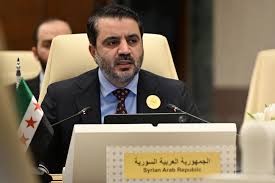The recent visit of Syrian Foreign Minister Assaad Hassan al-Shibani to New York has sparked a flurry of speculation—much of it inflated—about a potential thaw in Syrian–American relations and a breakthrough on the sanctions file. But behind the image of the three-starred Syrian flag raised outside the UN headquarters lies a more sobering reality: a diplomatic mission long on ceremony but short on results.
A Diplomatic Debut in Name Only
Shibani’s first appearance on U.S. soil since assuming his post was technically not a bilateral visit, but rather a participation in multilateral forums: the UN in New York and previously, the IMF and World Bank meetings in Washington—though notably, he was only granted a visa for New York. His meetings with American officials were described as limited, and key engagements in Washington, where the real diplomatic muscle resides, were absent.
This came on the heels of a more meaningful development in Damascus: a visit by Republican Senators Marlin Stutzman and Cory Mills, who met with President Ahmad al-Sharaa and Shibani to discuss U.S. conditions for sanctions relief. These were first conveyed by Deputy Assistant Secretary of State Natasha Franceschi at the Syria Donors Conference in Brussels and include eight specific demands—among them, dismantling remaining chemical weapons stockpiles, distancing the government from foreign fighters, counterterrorism cooperation, and efforts to locate missing American journalist Austin Tice.
Symbolic Steps, Stubborn Realities
Shibani’s speech at the UN focused on one key theme: lifting sanctions as a prerequisite for Syrian stability. He argued that while Syria has opened its doors to returnees and investors, outdated sanctions are stifling reconstruction and hindering economic revival. However, the response from Washington remained cautious.
U.S. Deputy Ambassador to the UN, Dorothy Shea, reiterated America’s position: optimism about the transitional government, yes—but not without proof. Washington, she stressed, is watching closely, expecting more inclusive appointments and structural reforms before taking any concrete steps. The tone was supportive, but the substance unchanged.
This cautious U.S. stance was echoed by other American officials. A State Department spokesperson reaffirmed that while the U.S. is reevaluating its Syria policy, no restoration of diplomatic ties is on the horizon, and nothing should be read into the New York meetings as indicative of a shift.
Opening Channels, Without a Breakthrough
While some analysts praised the visit for reactivating Syria’s presence in international diplomacy and engaging with global actors, few mistook it for a turning point. Benjamin Feve, a senior analyst with the Karam Shaar consultancy, called the visit “a symbolic gesture that lays the groundwork for future talks,” but admitted it failed to resolve any of the core issues—sanctions, reconstruction, or Israeli military activity in Syria.
The mixed nature of the visit was summed up by Syrian journalist and researcher Firas Allawi, who called it a “partial success”: it allowed Syria’s transitional foreign minister to show face at the UN, but yielded no real engagement from the U.S. administration or policy shifts on sanctions.
Compounding the ambiguity was the absence of clarity around who exactly Shibani met in New York. Beyond a confirmed meeting with Dorothy Shea, the rest remains speculative. Some Republican figures still view Syria’s transitional institutions—particularly those with roots in former opposition movements—as problematic or even terrorist-linked, limiting the political room for manoeuvre.
Missed Opportunities and Structural Deficits
According to academic and foreign policy expert Dr. Jamal Sayyid Ahmad, the visit suffered not only from American ambivalence but also from weaknesses within the Syrian transitional establishment itself. Foreign policy, he noted, is not public relations—it’s the art of mutual interests. Syria, he argued, lacks both a strategic policy engine and the institutional tools to translate its political objectives into actionable diplomacy.
Moreover, he cautioned against the “desperate” pursuit of sanctions relief at any cost, describing it as counterproductive. Without professional policy-making bodies to chart a phased roadmap for normalisation, Syria risks appearing reactive rather than strategic in its outreach to Washington.
Professor Hussein Deek also offered a sobering perspective: this was not a bilateral visit, but a protocol-driven appearance at an international body. “It’s important not to conflate the two,” he said, noting that official relations between the two governments remain frozen despite intermittent visits from U.S. Congress members and American diplomats like Barbara Leaf.
The Road Ahead: Rhetoric vs Reform
As the June–July deadline approaches for the renewal of U.S. General License 24, which enables limited humanitarian and economic activity in Syria, the clock is ticking. Syrian-American figures are lobbying for an extension of the license’s duration—from six months to a year or more—as well as the inclusion of expanded economic provisions. But without meaningful reforms from Damascus, progress is unlikely.
Ultimately, Shibani’s visit reflected a broader pattern in Syrian diplomacy: a willingness to engage, but without the institutional reforms or credibility needed to unlock trust. The doors may be open, but what lies beyond remains unclear.
This article was translated and edited by The Syrian Observer. The Syrian Observer has not verified the content of this story. Responsibility for the information and views set out in this article lies entirely with the author.


